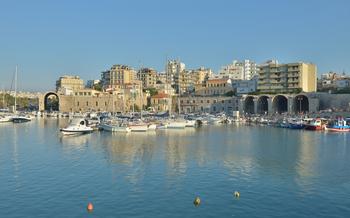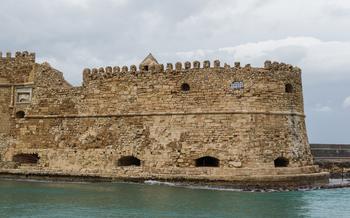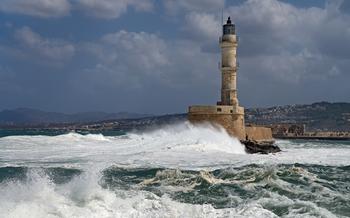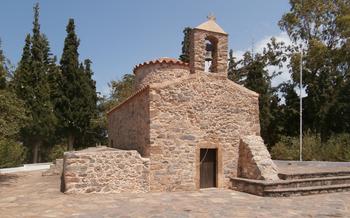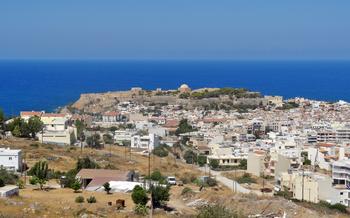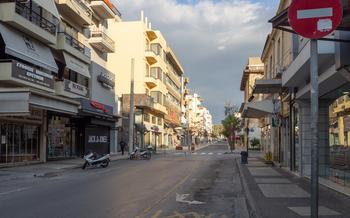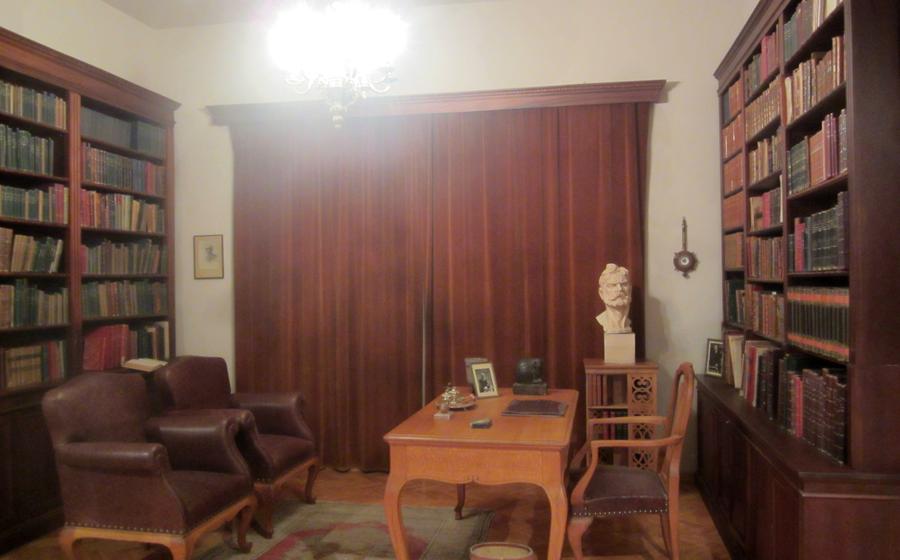
Historical Museum of Crete
- Historical Background
- Museum Exhibits
- Minoan Civilization
- Venetian and Ottoman Periods
- Archaeological Sites
- Temporary Exhibitions
- Educational Programs
- Museum Shop: A Treasure Trove of Cretan Culture
- Accessibility
- Photography and Social Media
- Research and Publications
- Local Cuisine
- Souvenirs and Local Crafts:
- Insider Tip:
Historical Background
Crete, the largest island in Greece, boasts a rich and diverse history that dates back to the Minoan era, one of the earliest known civilizations in Europe. Heraklion, the island's capital, played a pivotal role throughout Crete's history, serving as the capital during the Venetian and Ottoman periods. The Historical Museum of Crete, located in the heart of Heraklion, offers visitors a captivating journey through the island's past, showcasing the diverse cultural influences that have shaped Crete into the vibrant and multifaceted destination it is today. The museum's exhibits provide a comprehensive overview of Crete's history, from the Minoan civilization to the present day, offering visitors a chance to delve into the depths of this ancient and storied land.
Museum Exhibits
The Historical Museum of Crete boasts an impressive collection of artifacts excavated from various archaeological sites across the island. These artifacts provide a glimpse into the rich cultural heritage and diverse influences that have shaped Crete's history. The museum is divided into different sections, each dedicated to a specific period or culture.
The Minoan section showcases the remarkable achievements of the Minoan civilization, which flourished on Crete during the Bronze Age. Here, visitors can admire the famous "Snake Goddess" figurine, a masterpiece of Minoan art that depicts a goddess holding snakes in her hands. The section also features other significant artifacts, such as elaborate pottery, jewelry, and tools, which shed light on the daily life, religious beliefs, and artistic achievements of the Minoans.
The Classical and Roman sections display artifacts from the periods of Greek and Roman rule in Crete. These include sculptures, coins, and inscriptions that provide insights into the island's political, economic, and cultural development during these times.
The Byzantine section, on the other hand, focuses on the Byzantine era, which left a lasting impact on Crete's history and culture. Visitors can explore a collection of icons, manuscripts, and other religious artifacts that showcase the artistic and spiritual traditions of the Byzantine period.
One of the highlights of the museum is the "Phaistos Disk," a mysterious disk covered in undeciphered symbols. Discovered in the Minoan palace of Phaistos, the disk has puzzled scholars for decades and remains one of the most enigmatic artifacts in the museum's collection.
Minoan Civilization
The Minoan civilization, which flourished on Crete during the Bronze Age (c. 2700-1450 BC), was one of the most advanced and sophisticated civilizations of its time. The museum's Minoan exhibits provide a fascinating glimpse into the daily life, religious beliefs, and artistic achievements of this remarkable culture.
One of the most striking features of Minoan civilization was its advanced art. Minoan artists created beautiful and intricate frescoes, sculptures, and pottery that depicted scenes from everyday life, religious rituals, and mythical creatures. The museum's collection includes some of the finest examples of Minoan art, including the famous "Snake Goddess" figurine, which portrays a goddess with snakes coiled around her arms and shoulders.
Another important aspect of Minoan culture was its unique writing system, known as Linear A. Linear A has not yet been fully deciphered, but it is believed to have been used for administrative and religious purposes. The museum displays several examples of Linear A inscriptions, including clay tablets and seal stones.
The Minoans were also skilled seafarers and traders. They established a vast maritime network that stretched across the Mediterranean Sea and beyond. The museum's exhibits include a variety of artifacts related to Minoan seafaring, such as ship models, anchors, and amphorae (large storage jars used for transporting goods).
Venetian and Ottoman Periods
During the Venetian rule, Crete experienced a period of economic and cultural prosperity. The Venetians left a lasting mark on the island's architecture, with fortified cities, elegant mansions, and imposing churches. One of the Venetian legacies is the Heraklion Fortress, an impressive fortification that once protected the city from invaders. The museum showcases various artifacts from this period, including Venetian coins, ceramics, and weapons.
The Ottoman conquest of Crete in the 17th century brought significant changes to the island. The Ottomans introduced new administrative structures, religious practices, and cultural influences. The museum's exhibits from this period include Ottoman manuscripts, textiles, and decorative arts. Visitors can also learn about the challenges faced by the Cretan population during the Ottoman occupation, such as the imposition of heavy taxes and the forced conversion to Islam.
Despite the challenges, the Ottoman period also saw the emergence of a vibrant Cretan culture, which blended elements from both the East and the West. This cultural fusion is reflected in the museum's exhibits, which showcase unique artistic styles and traditions that emerged during this time. Exploring the museum's Venetian and Ottoman collections provides visitors with a deeper understanding of Crete's rich and complex history.
Archaeological Sites
Heraklion is the gateway to a treasure trove of archaeological wonders that provide a tangible connection to Crete's storied past. Just a short journey from the Historical Museum of Crete, history buffs can delve deeper into the island's ancient legacy by visiting these must-see archaeological sites.
-
Palace of Knossos: Unearth the secrets of the Minoan civilization at the Palace of Knossos, the legendary home of King Minos. Marvel at the intricate frescoes, explore the grand halls and chambers, and immerse yourself in the myths and legends that surround this iconic site.
-
Minoan Settlement of Akrotiri: Step back in time at the Minoan settlement of Akrotiri, a remarkably preserved Bronze Age town buried under volcanic ash. Explore the well-preserved streets, houses, and workshops, and admire the stunning frescoes and artifacts that offer a glimpse into the daily life of the Minoans.
-
Ancient City of Gortys: Discover the ancient city of Gortys, once a powerful city-state and the capital of Roman Crete. Explore the impressive ruins of the Roman theater, the Temple of Apollo Pythios, and the Odeon, and learn about the city's rich history and cultural heritage.
Temporary Exhibitions
The Historical Museum of Crete hosts a dynamic program of temporary exhibitions that delve into specific themes or topics related to the island's rich history and culture. These exhibitions showcase a diverse range of artifacts, artworks, and historical documents, offering visitors a deeper understanding of Crete's multifaceted heritage.
Past exhibitions have explored a wide variety of subjects, from the Minoan civilization's relationship with the sea to the influence of Venetian art and architecture on Crete. Visitors can expect to encounter unique and captivating displays that shed new light on the island's past.
To stay informed about upcoming exhibitions, visitors are encouraged to check the museum's website or follow its social media channels. These platforms provide regular updates on exhibition schedules, themes, and special events, ensuring that visitors can plan their visit accordingly.
Whether you are a history buff, an art enthusiast, or simply curious about Crete's cultural heritage, the Historical Museum of Crete's temporary exhibitions offer a rewarding and enriching experience. Make sure to include them in your itinerary to gain a comprehensive understanding of this fascinating island.
Educational Programs
The Historical Museum of Crete offers a variety of educational programs designed to enhance visitors' understanding of Crete's rich history and culture. These programs are tailored to different audiences, including families, students, and seniors, and are led by experienced educators and experts in Cretan studies.
Guided tours are available in multiple languages and provide an in-depth exploration of the museum's exhibits. Visitors can choose from a variety of tour themes, focusing on specific periods or aspects of Crete's history, such as the Minoan civilization, the Venetian and Ottoman periods, or the island's role in modern Greece.
Lectures and workshops are also offered on a regular basis, covering a wide range of topics related to Crete's history, archaeology, and culture. These programs feature presentations by leading scholars and experts, and provide opportunities for participants to engage in discussions and ask questions.
The museum also offers educational programs specifically designed for families and children. These programs include interactive activities, games, and storytelling sessions that make learning about Crete's history fun and engaging for younger visitors.
For those interested in delving deeper into Crete's cultural heritage, the museum also offers research opportunities. Visitors can access the museum's library and archives, which contain a wealth of resources on Crete's history, archaeology, and culture. Researchers can also collaborate with the museum's staff on specific projects or conduct their own independent research.
The museum's educational programs are an excellent way to gain a deeper understanding of Crete's rich history and culture. Whether you are a casual visitor or a serious scholar, there is something for everyone at the Historical Museum of Crete.
Museum Shop: A Treasure Trove of Cretan Culture
The Historical Museum of Crete houses a well-stocked museum shop that offers a diverse range of souvenirs, books, and educational materials related to the island's rich history and culture. Visitors can browse through a selection of books on Minoan civilization, Venetian architecture, and Byzantine art, as well as guidebooks and maps to help plan their exploration of Crete. The shop also features a variety of replicas of ancient artifacts, such as Minoan pottery, Roman coins, and Venetian glassware, allowing visitors to take home a piece of Crete's past. By purchasing items from the museum shop, visitors not only support the museum's educational and research initiatives but also contribute to the preservation and promotion of Crete's unique cultural heritage.
Accessibility
The Historical Museum of Crete is committed to providing an inclusive and welcoming environment for all visitors, regardless of their abilities. The museum features a number of accessibility features to ensure that everyone can enjoy the exhibits and learn about Crete's rich history.
Wheelchair ramps and elevators are available throughout the museum, allowing visitors with disabilities to easily navigate the different floors and galleries. Audio guides are also available in multiple languages, providing visitors with detailed information about the exhibits in a format that is accessible to those with hearing impairments.
The museum staff is also trained to assist visitors with disabilities and can provide additional support if needed. For example, they can help visitors find accessible restrooms, arrange for sign language interpretation, or provide assistance with transportation to and from the museum.
By offering these accessibility features and services, the Historical Museum of Crete ensures that everyone has the opportunity to explore and learn about the fascinating history of Crete.
Photography and Social Media
The Historical Museum of Crete encourages visitors to capture and share their experiences through photography. However, it is important to be mindful of the museum's policy on photography and social media. Flash photography and tripods are not allowed to preserve the artifacts and artwork. Visitors are welcome to take photographs for personal use, but commercial photography requires prior permission.
The museum actively engages with visitors on social media platforms. By using specific hashtags or tags, visitors can share their photos and experiences, connecting with a broader community interested in Crete's history and culture. The museum's social media channels also provide updates on upcoming exhibitions, events, and educational programs, allowing visitors to stay informed and engaged.
Research and Publications
Beyond its role as a museum, the Historical Museum of Crete is also a renowned center for research and scholarship on the island's history and culture. The museum houses a specialized library and archive, which contain a wealth of primary sources, documents, and artifacts that are invaluable to researchers. The museum's team of experts conducts extensive research on various aspects of Crete's past, from the Minoan civilization to the Venetian and Ottoman periods.
The museum's research findings are disseminated through a variety of publications, including books, journals, and research papers. These publications contribute to the field of Cretan studies and provide valuable insights into the island's rich cultural heritage. The museum also organizes conferences, workshops, and seminars to foster collaboration among scholars and promote knowledge sharing.
By engaging in research and publishing scholarly works, the Historical Museum of Crete plays a crucial role in preserving and disseminating knowledge about Crete's past. Its publications serve as a valuable resource for researchers, students, and anyone interested in learning more about this fascinating island.
Local Cuisine
After immersing yourself in history and culture at the Historical Museum of Crete, take a culinary journey and sample the delectable flavors of traditional Cretan cuisine. Venture into the charming streets of Heraklion and discover local restaurants or cafes that serve authentic Cretan dishes. Indulge in the simplicity and freshness of "dakos," a traditional dish made from barley rusks topped with ripe tomatoes, crumbled feta cheese, and a drizzle of olive oil. For a more substantial meal, try "gamopilafo," a hearty wedding pilaf made with rice, lamb, and aromatic spices.
Cretan cuisine is a testament to the island's unique history and geography. Its dishes are influenced by the Mediterranean Sea, the fertile land, and the island's rich cultural heritage. Fresh seafood, seasonal vegetables, and locally-produced olive oil are staples of the Cretan diet and feature prominently in many dishes. Don't miss the chance to taste the island's famous cheeses, such as "graviera" and "mizithra," which are often used in local dishes and pastries.
For a truly immersive experience, ask locals for recommendations or venture off the beaten path to discover hidden culinary gems. Whether you prefer a casual meal in a traditional taverna or a fine-dining experience with a modern twist on Cretan cuisine, Heraklion offers a diverse culinary scene that will satisfy every palate.
Souvenirs and Local Crafts:
The Historical Museum of Crete is not only a treasure trove of ancient history and artifacts; it also offers a unique opportunity to immerse yourself in Crete's vibrant contemporary culture through its museum shop. Here, you'll find a carefully curated selection of locally-made souvenirs and crafts that showcase the island's rich artistic traditions and craftsmanship.
From intricately painted pottery and gleaming jewelry to delicate woven textiles and hand-crafted leather goods, the museum shop offers a diverse range of authentic Cretan souvenirs. Whether you're looking for a unique gift for a loved one or a memento to remind you of your time on the island, you're sure to find something special here.
By supporting the museum shop, you not only take home a piece of Crete's cultural heritage but also contribute to the preservation and promotion of traditional crafts on the island. These crafts are an integral part of Crete's identity, and the museum shop provides a platform for local artisans to showcase their skills and artistry.
So, after exploring the museum's fascinating exhibits, be sure to visit the museum shop to discover the treasures that await. From colorful ceramics and intricate jewelry to hand-woven textiles and traditional leatherwork, you're sure to find something that captures the essence of Crete and makes for a meaningful and memorable souvenir.
Insider Tip:
For those seeking a unique experience, venture beyond the main galleries to discover the museum's hidden gem, the "Sculpture Garden." Nestled in a tranquil courtyard, this outdoor oasis showcases a collection of ancient sculptures, including colossal statues, intricate reliefs, and funerary monuments. Stroll among these awe-inspiring works of art, immerse yourself in their stories, and let your imagination transport you back to ancient Crete.
